Artificial intelligence tools outperform standard methods for breathing tube placement, oxygen monitoring and pain assessment in pediatric anesthesia, with machine learning systems providing 60-second warning of dangerous oxygen drops.
A systematic review of 10 studies presented at the ANESTHESIOLOGY 2025 annual meeting found AI performed better than current approaches across critical pediatric anaesthesia tasks. The technology analysed thousands of data points in real time to predict complications, enhance clinical accuracy and enable earlier intervention when problems occurred during surgery.
Researchers trained AI systems on second-by-second data from more than 13,000 surgeries to monitor children’s oxygen levels. The most efficient model warns anesthesiologists up to 60 seconds before standard alarm systems sound by analysing breathing, oxygen and heart data to spot changes humans cannot detect. This additional minute allows time to adjust ventilators, clear secretions or address airway problems before oxygen levels become dangerously low.
Aditya Shah, B.S., lead author of the study and a medical student at Central Michigan University College of Medicine, Saginaw, described AI as support rather than replacement for clinical expertise. “AI can continuously analyse thousands of data points in real time and learn patterns from past cases, spotting subtle changes sooner and helping tailor decisions to each child’s unique anatomy,” he said. “However, it does not replace the anesthesiologist’s training and expertise; it simply adds another layer of safety and support.”
Pain levels in children
Pain assessment accuracy improved from 85-88 per cent with current observation-based methods to 95 per cent using AI trained on more than 1,000 assessments of 149 toddlers. The system recognised patterns in crying, agitation, guarding and facial expressions to determine pain levels in children who cannot communicate their discomfort.
Machine learning models reduced errors in breathing tube size and depth placement by 40-50 per cent compared to age-based or height-based formulas. A study of 37,000 children found AI used patient characteristics to predict appropriate tube specifications more accurately than standard calculations, reducing risks of airway injury and inadequate oxygen delivery.
Although AI tools for pediatric anaesthesia remain in the research stage, their demonstrated benefits make incorporation into clinical practice likely in the near future, Shah said.











